Occurrence State and Time-Shift Characteristics of Residual Oil in Low-Permeability Reservoirs After Long-Term Waterflooding in Changqing Oilfield
Abstract
1. Introduction
2. Experimental Methods
2.1. Samples
2.2. Three-Dimensional Digital Core Construction
3. Characterization of Microscopic Pore Structure
- (1)
- The physical properties of 6-5 and 5-5 are better: a wider range of coordination numbers, a higher radius of the mainstream pore throat, and the development of large-scale pore throats and more regular pore-throat shapes.
- (2)
- The physical properties of 12-7, 11-9, and 13-6 are poor: low coordination number, a small radius of mainstream pores, a small radius of throats, and high resistance to fluid transfer (viscous and capillary resistance).
- (3)
- By comparing and analyzing the test results of five cores, it can be seen that the larger the core pore throat radius is, the higher the core permeability is accordingly, reflecting that the size of the pore throat and connectivity are the main factors determining the permeability of the reservoir.
4. Microsimulation of Waterflooding
4.1. Experimental Program
- Oil washing and drying of the cores and CT scanning of dry millimeter core subsamples;
- Low-speed injection of 100 PV brine to saturate the core with water;
- Oil displacement and CT scanning (irreducible water process and original oil distribution);
- Waterflooding and CT scanning at 1 PV, 5 PV, and 30 PV (dynamic waterflooding process and oil–water distribution).
4.2. Characteristics of Microscopic Residual Oil
- (1)
- After the large PV waterflooding, the oil displacement efficiency of different cores was as follows: 6-5 > 5-5 > 12-7 > 11-9 > 13-6; under the same level of pore–throat scale, the effect of large PV waterflooding was single-peak type > multiple-peak type: 6-5 > 5-5/12-7 > 11-9; under the same level of degree of non-homogeneity, the effect of large PV waterflooding was large pore throats > small pore throats: 6-5 > 5-5/11-9 > 13-6. There was more multi-peaked clustered/porous residual oil than single-peaked, and the proportion of continuous-state clustered residual oil gradually decreased and the total proportion of discontinuous-state residual oil gradually increased as the drive proceeded; the non-homogeneity was not conducive to the maintenance of the wave volume.
- (2)
- The remaining oil transformed from a continuous phase (clusters) to a discontinuous phase (porous, drops, columns, ad membranes) under the washout of the large PV drive medium. Before 5 PV, the proportion of clustered residual oil increased, a certain thickness of oil film existed between the oil phases as a flow channel, and the oil phase continuity was good. That is, the decrease in oil phase continuity was the main factor leading to the decrease in oil phase permeability.
- (3)
- The evolution law of the proportion of residual oil type can indicate that the large PV waterflooding could effectively expand the wave volume, but the local oil drive efficiency decreased. Columnar, droplet, and membrane shapes depended on core local connectivity, local wettability, and local pore-throat shapes, respectively; the percentage of residual oil after hydrodynamics indicated that the worse the physical properties, the lower the local efficiency of hydrodynamics (discontinuous oil phases were the most abundant).
- (4)
- During long-term waterflooding, the clustered flow remained the most widely distributed type. As the cumulative displacement intensity continued to increase, the clustered residual oil in large pore throats was displaced and became more enriched in smaller pores, i.e., distributed in pores with smaller coordination numbers. The coordination number and pore–throat ratio had little influence on this process. For the four types of discontinuous residual oil, as the cumulative displacement intensity increased, more clustered oil transitioned into the discontinuous type. The pore radius and coordination number associated with these discontinuous types also increased, and they predominantly existed in the main high-permeability waterflooding paths.
- (5)
- During the initial oil saturation stage, the oil phase primarily existed as continuous clusters (accounting for approximately 90% saturation), which represented the main recoverable potential where conventional waterflooding remained effective. In the early waterflooding stage, the oil phase transitions from continuous to discontinuous distribution, forming isolated clusters through stripping and fingering effects in un-swept or weakly swept zones, where enhanced injection intensity is recommended along with potential viscosity modifiers or structured polymers to improve displacement efficiency. During mid-stage waterflooding, discontinuous oil (including isolated clusters and columns) gradually increases, making surfactant injection viable to reduce interfacial tension and mobilize residual oil, while viscoelastic polymer solutions can enhance microscopic displacement through improved viscosity and elasticity. In late-stage waterflooding, advanced EOR methods should be implemented: polymer microspheres for throat plugging and viscosity enhancement, combined with wettability alteration techniques such as clay-surface organic dissolution, multi-ion exchange, and low-salinity water injection, to improve hydrophilic capacity and overall recovery efficiency.
5. Conclusions
- (1)
- The combination of digital core technology and two-phase microscopic seepage simulation can reproduce the microscopic replacement process under the real pore structure of reservoir core, which is of great significance for clarifying the mechanism of residual oil formation in waterflooding reservoirs as well as the effective utilization of residual oil.
- (2)
- Large PV waterflooding can effectively expand the wave volume, but the local oil drive efficiency decreases, the non-homogeneity is not conducive to maintaining the wave volume, and the local connectivity, local wettability, and local pore-throat shape of the core determine the characteristics of the residual oil storage after the drive.
- (3)
- The remaining oil in the reservoir core of the study area mainly consists of membrane residual oil, droplet residual oil, columnar residual oil, and porous residual oil. Before displacement, the microscopic residual oil is mainly in the form of continuous clusters, porous and dispersed large blocks, and columns; after displacement, the microscopic residual oil is mainly in the form of dispersed drops, membranes, smaller blocks, and columns. The occurrence state of continuous clustered residual oil is most significantly influenced by pore radius, whereas the distribution of the four discrete types of residual oil exhibits broader ranges of pore radius, throat-to-pore ratio, and coordination number, with their flow dynamics being less affected by heterogeneity.
- (4)
- During the medium–low water cut stage, the oil primarily exists as continuous clusters within pore spaces. At this stage, conventional waterflooding methods remain predominant. With the increasing presence of discontinuous residual oil (e.g., porous-type and columnar-type), the viscosity enhancement of the displacing phase or the addition of novel structured polymers/surfactants should be considered. In the late-stage waterflooding phase, recoverable residual oil mainly occurs as cluster-type, film-type, and minor isolated-cluster-types, where nano-scale polymer microsphere flooding may be employed as an effective EOR method.
Author Contributions
Funding
Data Availability Statement
Conflicts of Interest
Abbreviations
| Parameter | Meaning |
| NMR | Nuclear magnetic resonance spectroscopy |
| CT | Computed tomography |
| PV | Pore volume multiplier |
| T2 | T2 spectrum, transverse relaxation time |
| SEM | Scanning electron microscopy |
References
- Zhou, L. Quantitative characterization technology and application of dominant injection-production direction in low-permeability sandstone reservoirs. Spec. Oil Gas Reserv. 2021, 28, 98–104. [Google Scholar] [CrossRef]
- Wang, L.; Xia, H.; Han, P.; Cao, R.; Sun, X.; Zhang, S. Microscopic characteristics of remaining oil distribution and quantitative characterization of its producibility. Lithol. Reserv. 2021, 33, 147–154. [Google Scholar] [CrossRef]
- Zhang, T. Residual Oil Micro-Distribution and Flow Characterization Based on CT Imaging Technology. Master’s Thesis, Southwest Petroleum University, Chengdu, China, 2017. [Google Scholar]
- Guo, C. Distribution characteristics of remaining oil after heterogeneous combination flooding based on sealed cored well: A case study in Zhongyi area Ng3, Gudao Oilfield. Pet. Geol. Recovery Effic. 2022, 29, 111–117. [Google Scholar] [CrossRef]
- Sun, P.; Cai, H.; Chen, X.; Yang, Z.; Yao, J. Oil-Water Occurrence Law in Typical High-Permeability Sandstone Reservoirs in the Bohai Sea Based on Microfluidic Modeling. Spec. Oil Gas Reserv. 2023, 30, 120–127. [Google Scholar] [CrossRef]
- Liu, Y.; Xia, H.; Zhang, S.; Wu, J.; Jiang, L.; Yang, K.; Li, K. Quantitative characterization of micro residual oil after polymer flooding based on digital pore model. J. China Univ. Pet. (Ed. Nat. Sci.) 2023, 47, 111–120. [Google Scholar] [CrossRef]
- Wang, Y.; Ge, L.; Lu, Y.; Song, H.; Zhang, Y. Study on fluid mobility and occurrence characteristics of remaining oil in low-permeability sandstone reservoirs based on nuclear magnetic resonance displacement experiments. Pet. Geol. Recovery Effic. 2023, 30, 22–31. [Google Scholar] [CrossRef]
- Yang, T.; Zhong, H.; Xia, H.; Zhao, X. Mechanism of residual oil mobilization after water flooding based on microscopic flow characteristics. Reserv. Eval. Dev. 2020, 10, 46–52. [Google Scholar] [CrossRef]
- Gao, H.; Sun, W.; Tian, Y.; Ren, G.; Lu, Y. Application of NMR technique in evaluation of micro-pore structure in extra-low permeability sandstone. Prog. Geophys. 2011, 26, 294–299. [Google Scholar] [CrossRef]
- Wang, J.; Cui, P.; Liu, S.; Shi, B.; Dang, H. Distribution Characteristics of Movable Fluid in Shale Oil Reservoirs with Different Pore Structures. J. Xi’an Shiyou Univ. (Nat. Sci. Ed.) 2023, 38, 59–68. [Google Scholar] [CrossRef]
- Ning, B.; Ren, D.; Wang, H.; Zhang, H.; Guo, J.; Fu, N.; Li, J.; Li, T.; Li, Q. Multi-scale combination characterization of micropore structure of tight sandstone gas reservoirs. Fault-Block Oil Gas Field 2024, 31, 34–41. [Google Scholar] [CrossRef]
- Wang, C.; Wang, F.; Liu, Z.; Jiao, L.; Zhao, J.; Yang, K. Pore structure characterization of tight oil reservoirs with fractal theory. In Proceedings of the International Field Exploration and Development Conference (IFEDC), Beijing, China, 11–12 August 2016. [Google Scholar]
- Li, J.; Liu, Y.; Gao, Y.; Cheng, B.; Meng, F.; XU, H. Effects of microscopic pore structure heterogeneity on the distribution and morphology of remaining oil. Pet. Explor. Dev. 2018, 45, 1043–1052. [Google Scholar] [CrossRef]
- Hou, J.; Qiu, M.; Lu, N.; Qv, Y.; Li, F.; Meng, X.; Shi, X. Characterization of residual oil micro distribution at pore scale using computerized tomography. Acta Pet. Sin. 2014, 35, 319–325. [Google Scholar]
- Liu, G.; Wang, L.; Sun, Z.; Wang, J.; Jiang, F. Research progress of pore-throat structure in tight sandstone formation. Pet. Sci. Bull. 2022, 7, 406–419. [Google Scholar] [CrossRef]
- Lin, C.; Wu, Y.; Ren, L.; Wang, Y.; Yan, W.; Sun, X.; Zhang, X.; Zhang, Y. Review of digital core modeling methods. Prog. Geophys. 2018, 33, 679–689. [Google Scholar] [CrossRef]
- Guo, Y.; Zhang, L.; Zhu, G.; Yao, J.; Sun, H.; Song, W.; YANG, Y.; Zhao, J. A pore-scale investigation of residual oil distributions and enhanced oil recovery methods. Energies 2019, 12, 3732. [Google Scholar] [CrossRef]
- Wei, B. Application of Digital Core Technology to Simulate High Temperature and High-Pressure Gas-Water Seepage. Master’s Thesis, Southwest Petroleum University, Chengdu, China, 2017. [Google Scholar]
- Gao, Y.; Jiang, H.; Wang, S.; Li, J.; Liu, C.; Chang, Y.; Wang, Y. Simulation analysis of microscopic water-oil displacement based on Level set method. China Offshore Oil Gas 2016, 28, 59–65. [Google Scholar] [CrossRef]
- Liao, Q. Digital Core Reconstruction and Seepage Simulation of Dense Sandstone. Master’s Thesis, China University of Geosciences (Beijing), Beijing, China, 2020. [Google Scholar]
- Zhu, Z. Remaining oil distribution patterns of metamorphic buried-hill fractured reservoir based on digital core technology. Spec. Oil Gas Reserv. 2019, 26, 148–152.157. [Google Scholar] [CrossRef]
- Guo, J.; Wang, D.; Wang, P.; Xiong, R.; Wang, H.; Wang, S. Pore Structure of Low-permeability Reservoir and Distribution Characteristics of Remaining Oil after Water Flooding Based on Digital Core. Spec. Oil Gas Reserv. 2023, 30, 101–108. [Google Scholar] [CrossRef]
- Nie, X.; Hu, J.; Wan, Y.; Zhang, C.; Zhang, Z. Reconstruction of 3D digital core model of carbonate rock based on Markov chain -Monte Carlo method. J. Yangtze Univ. (Nat. Sci. Ed.) 2021, 18, 28–35. [Google Scholar] [CrossRef]
- Zhao, W.; Wu, K.; Jiang, L.; He, M.; Li, X.; Jia, C. Charging and microscopic gas-water occurrence characteristics of tight sandstone gas based on pore network model. Nat. Gas Ind. 2022, 42, 69–79. [Google Scholar] [CrossRef]
- Wang, X.; Xun, J.; Peng, X.; Zhang, C.; Yuan, W.; Wang, Y. Flow mechanism and pore structures of tight sandstone based on digital core analysis. Pet. Geol. Recovery Effic. 2022, 29, 22–30. [Google Scholar] [CrossRef]
- Gao, S.; Yang, M.; Ye, L.; Liu, H.; Zhu, W. Simulation experiment of water invasion performance in low-permeability bottom water gas reservoir and its influence on recovery factor. Nat. Gas Ind. 2022, 42, 61–70. [Google Scholar] [CrossRef]
- SY/T 5336-2006; Core Analysis Methods. Petroleum Industry Press: Beijing, China, 2007.
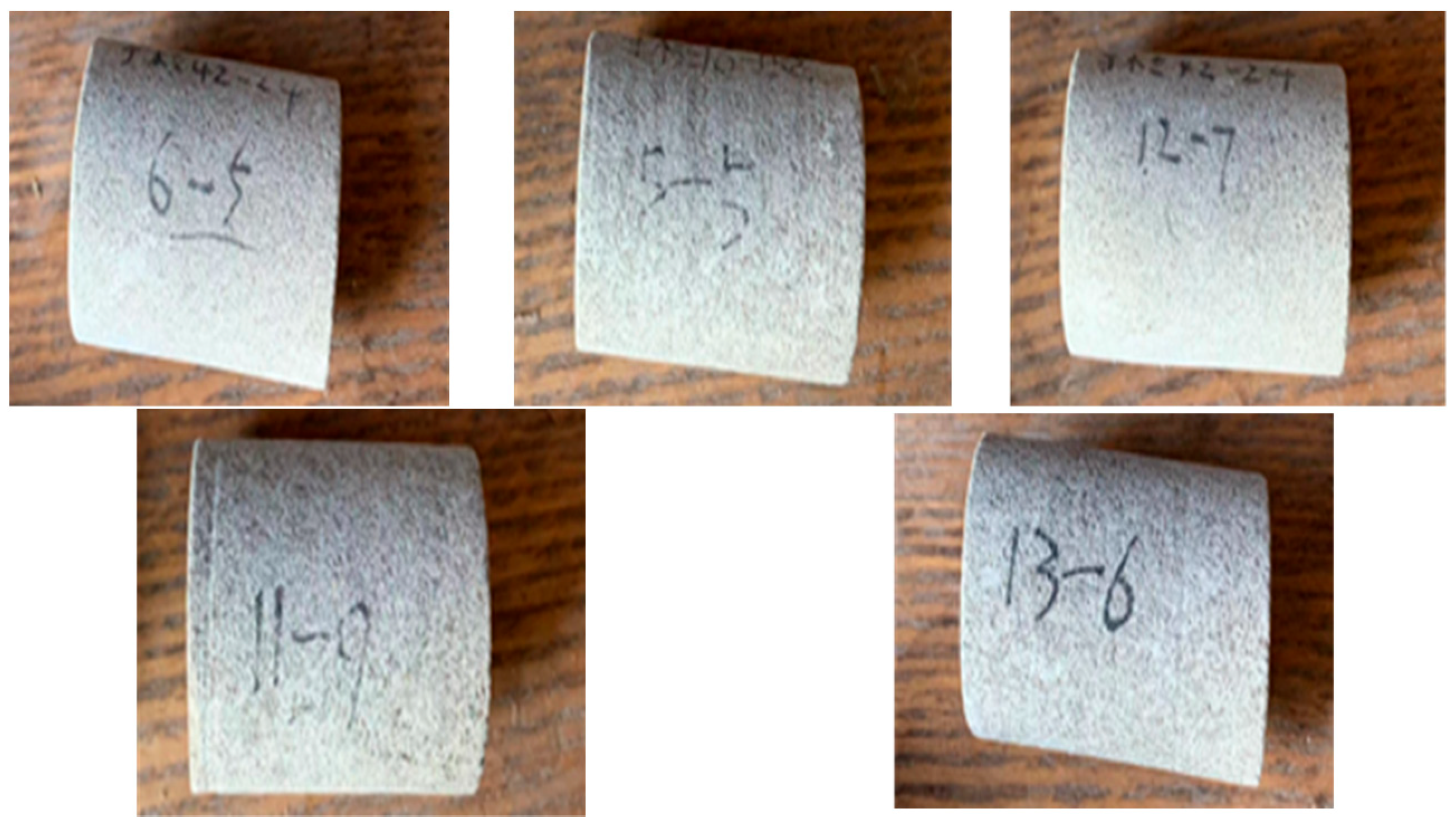
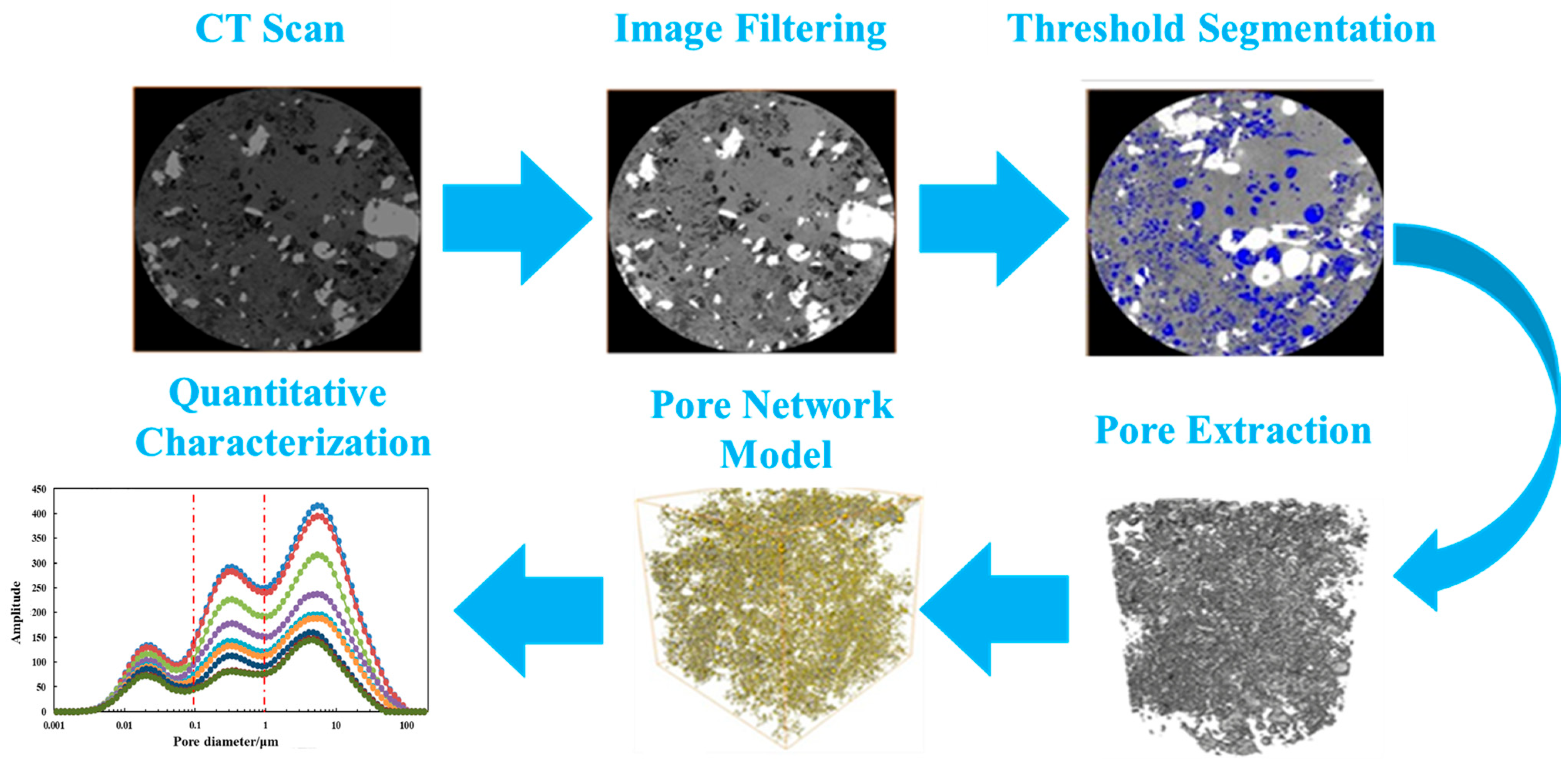

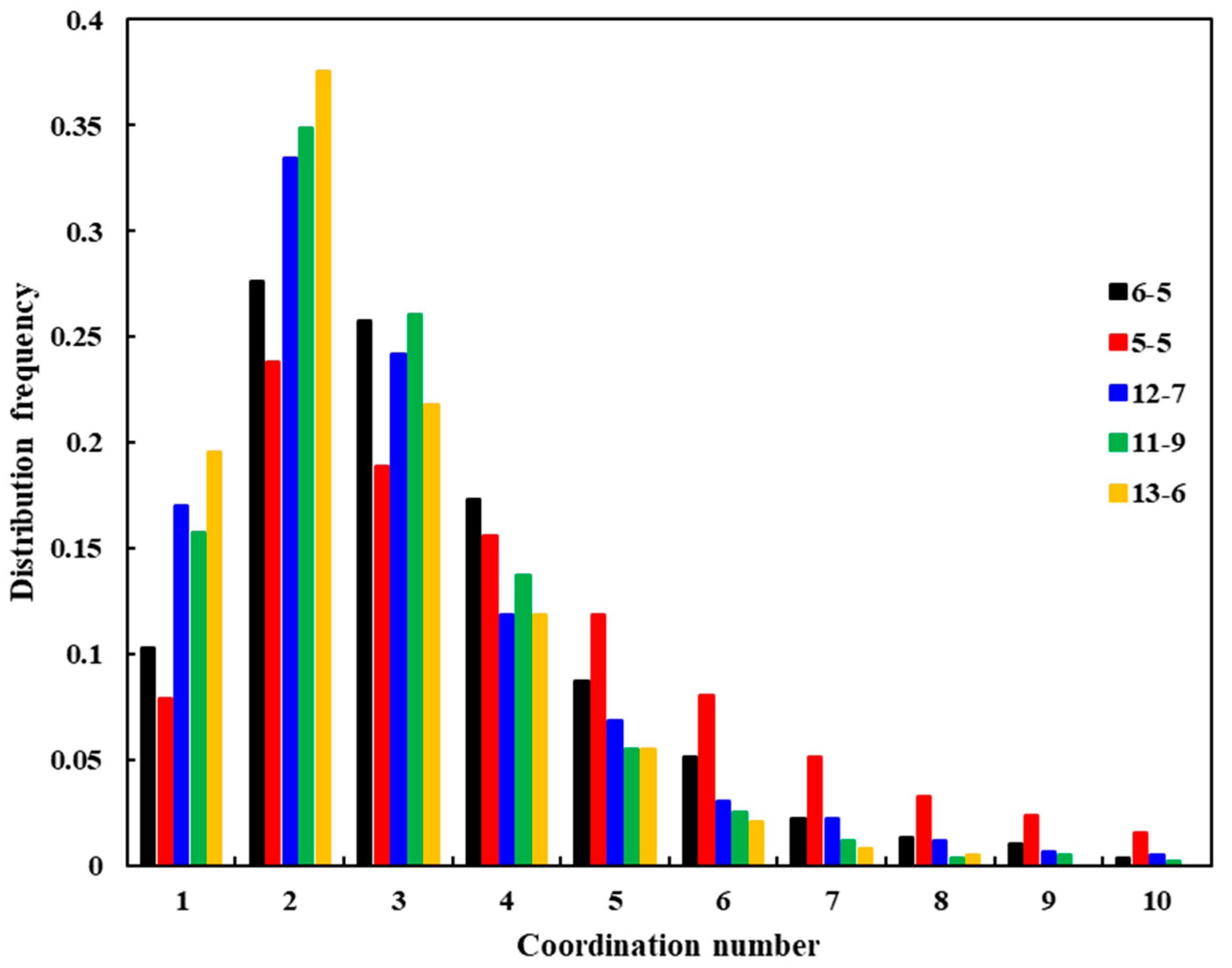
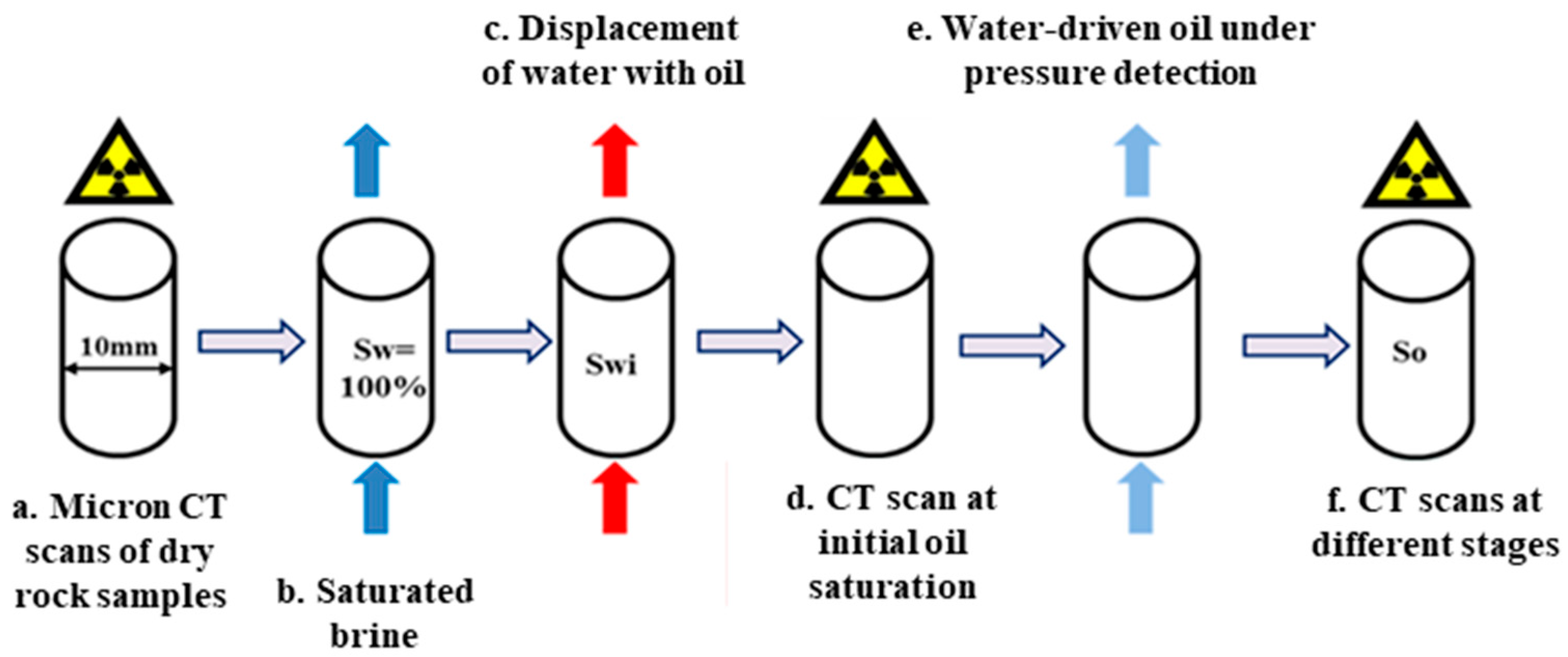


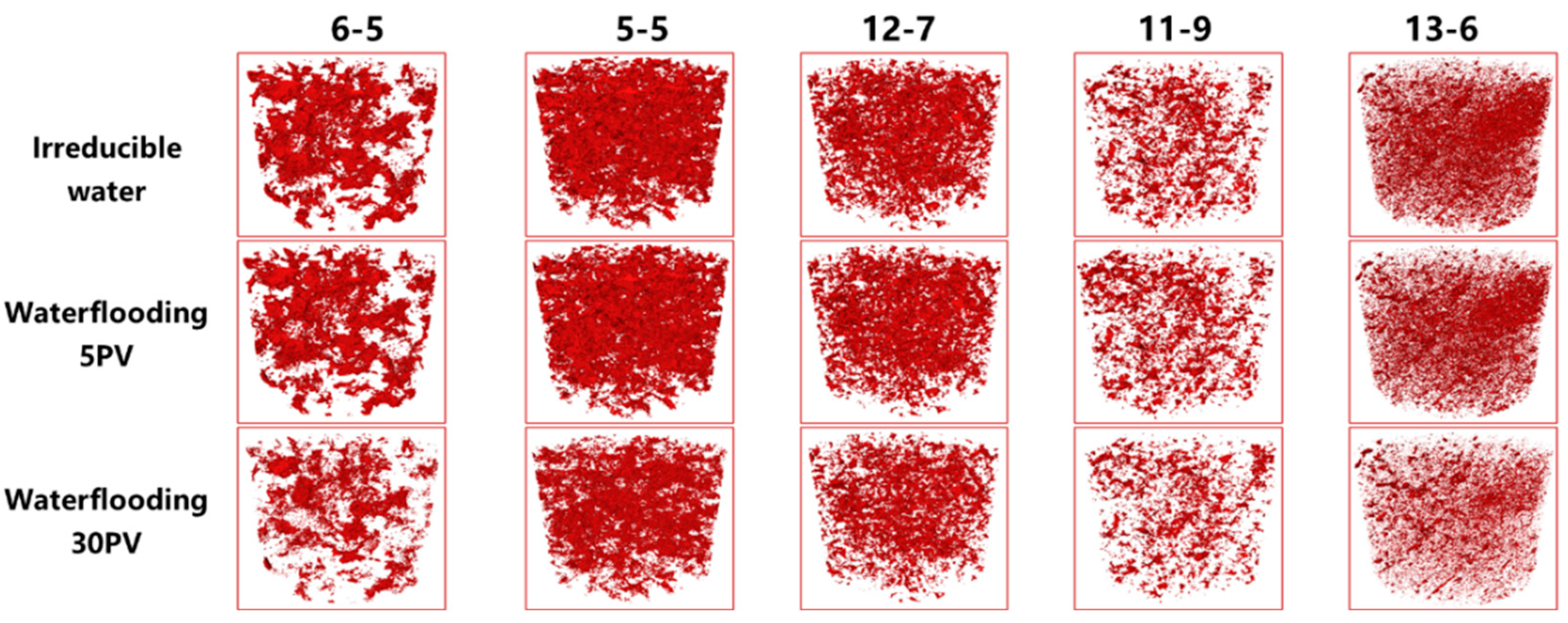
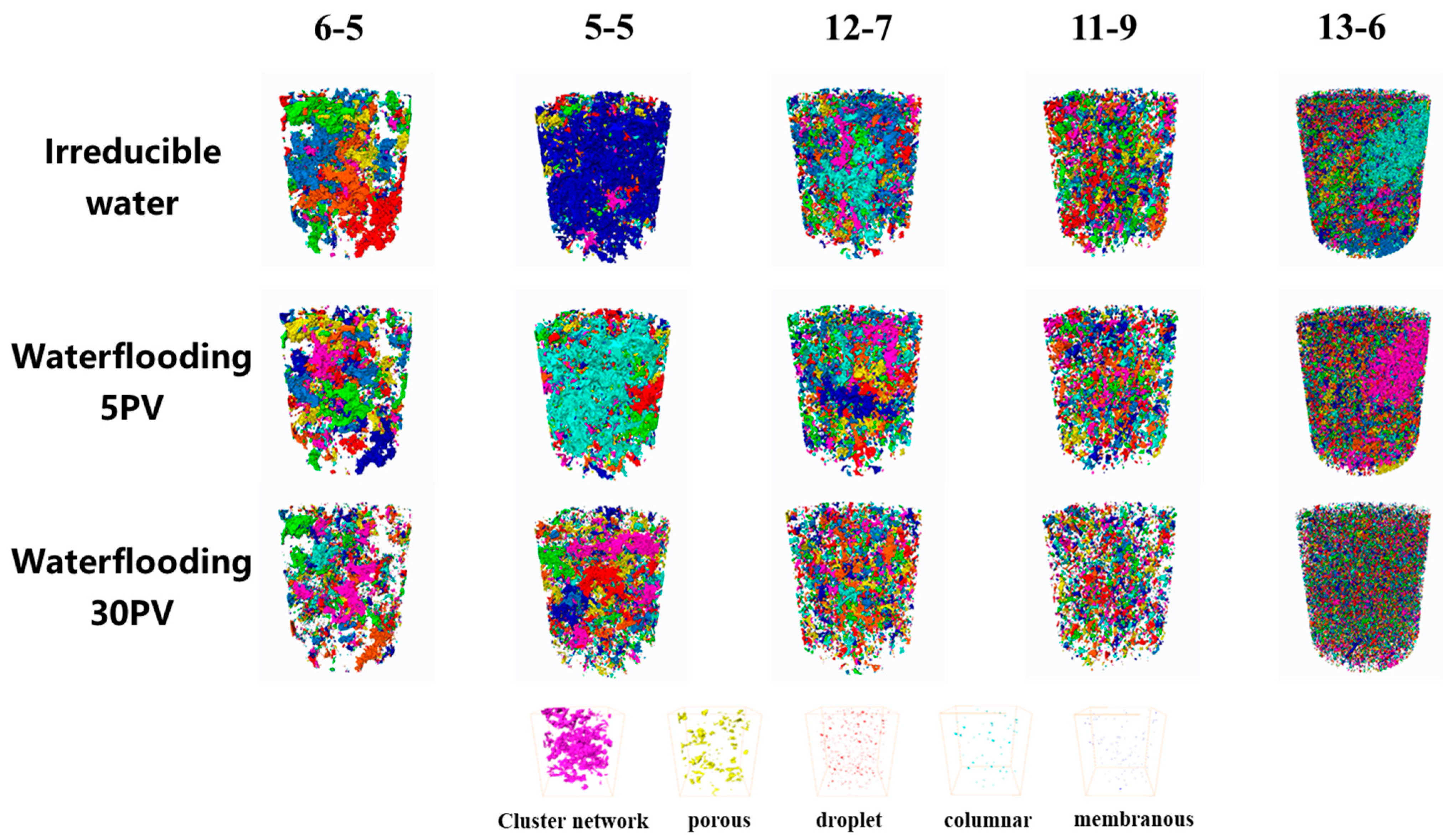
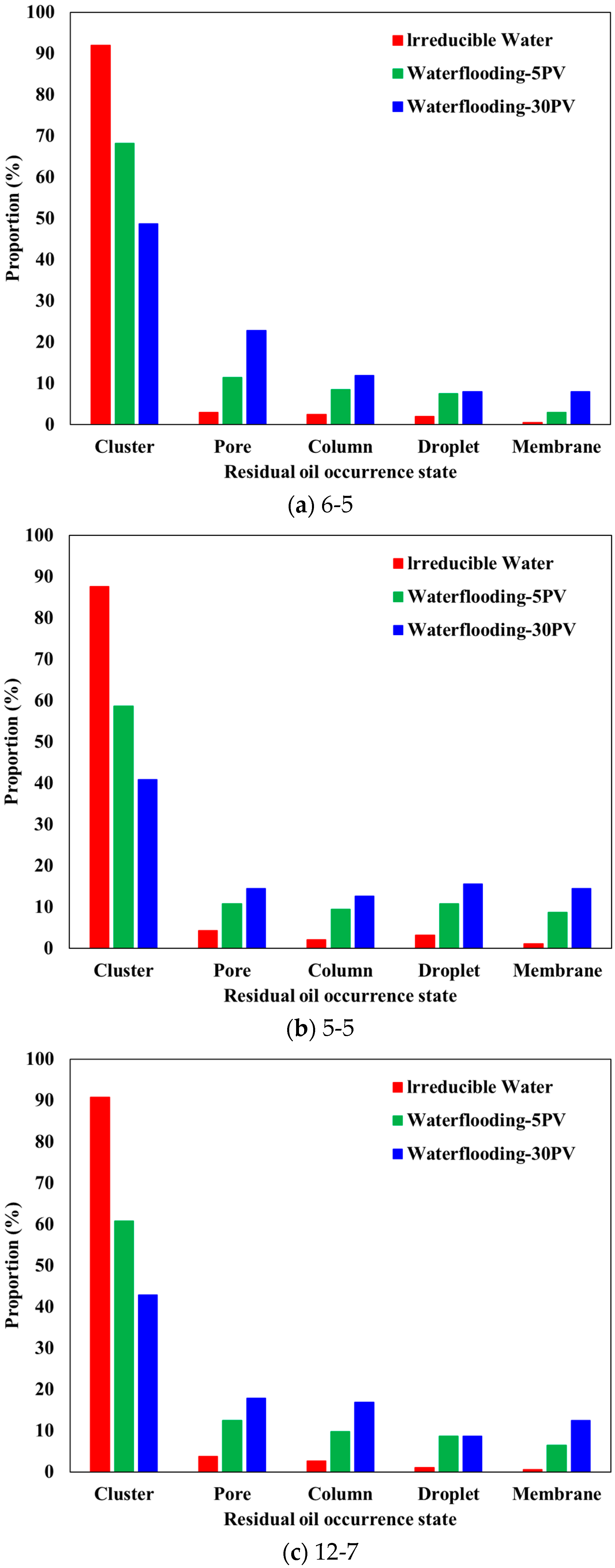
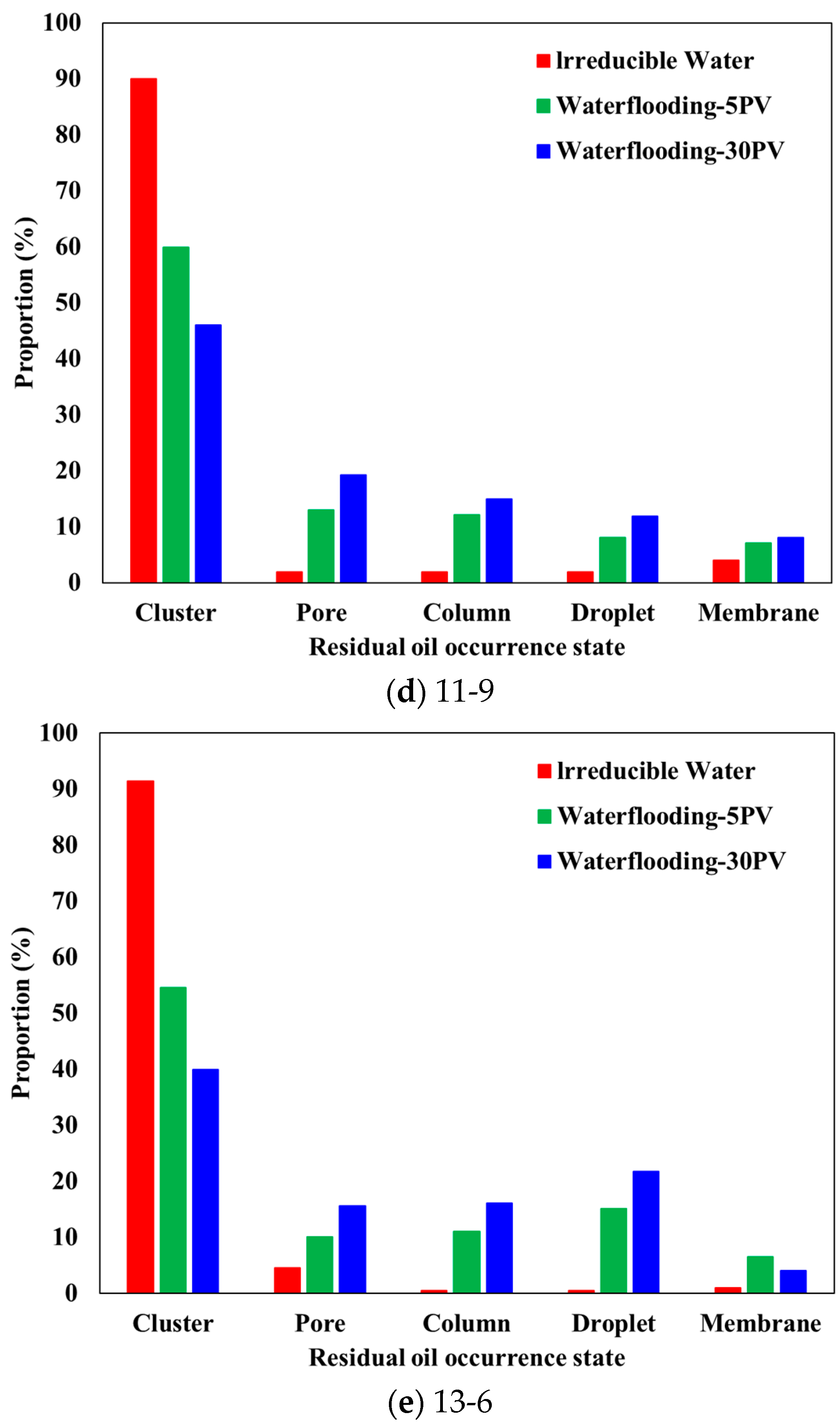

| Core Number | Properties | Length/cm | Diameter/cm | Porosity/% | Permeability/mD | Reservoir Type |
|---|---|---|---|---|---|---|
| 6-5 | fine sandstone | 4.06 | 2.46 | 14.95 | 10.812 | low permeability |
| 5-5 | fine sandstone | 4.45 | 2.46 | 13.59 | 7.449 | ultra-low permeability |
| 12-7 | fine sandstone | 4.05 | 2.46 | 12.71 | 4.512 | ultra-low permeability |
| 11-9 | fine sandstone | 4.47 | 2.46 | 12.94 | 2.259 | ultra-low permeability |
| 13-6 | fine sandstone | 4.46 | 2.46 | 9.12 | 1.237 | ultra-low permeability |
| Core Number | Coordination Number | Main/Average Pore Radius | Main/Average Roar Radius | Classification |
|---|---|---|---|---|
| 6-5 | 1–9 | 8.71/18.01 | 6.93/9.07 | Coarse multi-peak |
| 5-5 | 1–10 | 7.71/14.78 | 5.86/6.55 | Coarse single-peak |
| 12-7 | 1–7 | 5.88/11.25 | 3.27/6.34 | Slight single-peak |
| 11-9 | 1–6 | 5.40/8.44 | 2.99/6.68 | Slight multi-peak |
| 13-6 | 1–6 | 4.44/5.56 | 0.83/3.00 | Slight single-peak |
| Parameter | Value | Parameter | Value |
|---|---|---|---|
| Pressure | 10 MPa | Number of samples | 5 |
| Temperature | Ordinary | Oil viscosity | 2.25 cp |
| Resolution ratio | 2~3 μm | Water viscosity | 1 cp |
| Sample diameter | 5~8 mm | Injection rate | 0.02 mL/min |
| Typology | State of Affairs | Typical Shape | Number of Pores and Throats Occupied | Form Factor (S) | Degree of Overlap (C) | Euler Number (E) |
|---|---|---|---|---|---|---|
| Discontinuous flow | Membranous |  | Less than 1/3 of the pore diameter | S > 2 | C < 0.4 | E > 0 |
| Droplet |  | Number of pores and throats ≤ 1 | S ≤ 2 | C = 0 | E > 0 | |
| Columnar |  | Number of pores and throats ≤ 1 | S > 2 | C ≥ 0.4 | E > 0 | |
| Porous |  | 1 < Number of connected pores < 5 | S > 2 | C ≥ 0.4 | E > −1 | |
| Continuous flow | Cluster network |  | Number of connected pores > 5 | S > 2 | C ≥ 0.4 | E ≤ −1 |
Disclaimer/Publisher’s Note: The statements, opinions and data contained in all publications are solely those of the individual author(s) and contributor(s) and not of MDPI and/or the editor(s). MDPI and/or the editor(s) disclaim responsibility for any injury to people or property resulting from any ideas, methods, instructions or products referred to in the content. |
© 2025 by the authors. Licensee MDPI, Basel, Switzerland. This article is an open access article distributed under the terms and conditions of the Creative Commons Attribution (CC BY) license (https://creativecommons.org/licenses/by/4.0/).
Share and Cite
Shangguan, Y.; Li, B.; Gao, C.; Jia, J.; Zhang, Y.; Wang, J.; Xu, T. Occurrence State and Time-Shift Characteristics of Residual Oil in Low-Permeability Reservoirs After Long-Term Waterflooding in Changqing Oilfield. Energies 2025, 18, 2001. https://doi.org/10.3390/en18082001
Shangguan Y, Li B, Gao C, Jia J, Zhang Y, Wang J, Xu T. Occurrence State and Time-Shift Characteristics of Residual Oil in Low-Permeability Reservoirs After Long-Term Waterflooding in Changqing Oilfield. Energies. 2025; 18(8):2001. https://doi.org/10.3390/en18082001
Chicago/Turabian StyleShangguan, Yangnan, Boying Li, Chunning Gao, Junhong Jia, Yongqiang Zhang, Jinghua Wang, and Tao Xu. 2025. "Occurrence State and Time-Shift Characteristics of Residual Oil in Low-Permeability Reservoirs After Long-Term Waterflooding in Changqing Oilfield" Energies 18, no. 8: 2001. https://doi.org/10.3390/en18082001
APA StyleShangguan, Y., Li, B., Gao, C., Jia, J., Zhang, Y., Wang, J., & Xu, T. (2025). Occurrence State and Time-Shift Characteristics of Residual Oil in Low-Permeability Reservoirs After Long-Term Waterflooding in Changqing Oilfield. Energies, 18(8), 2001. https://doi.org/10.3390/en18082001





